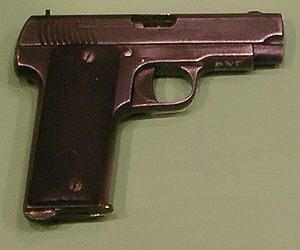Ruby pistol
| Ruby | |
|---|---|

Cebra marked Ruby-type pistol manufactured by A. Zulaika, Museum of the Polish Army, Warsaw
|
|
| Type | Semi-automatic handgun |
| Place of origin | Spain |
| Service history | |
| Used by | See Users |
| Wars |
World War I Polish–Soviet War Polish–Lithuanian War Spanish Civil War Winter War World War II |
| Production history | |
| Designer | John Moses Browning, Esperanza y Unceta Cia, Pedro Careaga and others |
| Designed | 1914 |
| Manufacturer | Gabilondo y Urresti and over 50 other firms |
| No. built | at least 750,000 |
| Variants | Over 50 variants |
| Specifications | |
| Weight | 850 g |
| Length | 170–210 mm |
| Barrel length | 80–120 mm |
|
|
|
| Cartridge | mainly 7.65 x 17 mm (.32 ACP) |
| Action | Blowback |
| Feed system | Detachable box magazine, 9 rounds |
| Sights | Fixed, or dovetail rear |
The self-loading Ruby pistol is best known as a French World War I sidearm, the Pistolet Automatique de 7 millim.65 genre "Ruby". A very international piece of weaponry, it was closely modeled after John Browning's M1903 design produced by the Belgian Fabrique Nationale de Herstal, and was produced by over 50 Spanish companies, but primarily by the Spanish Gabilondo y Urresti firm (the official "Gabilondo Ruby"). It was decommissioned in 1958, more than a decade after World War II was brought to an end, and was subsequently replaced.
In 1914, just before the start of the First World War, Gabilondo started manufacture of a sturdy self-loading pistol based on the Browning Model 1903 and chambered for the 7.65mm Browning/.32 ACP cartridge. Unusual for the time, the magazine capacity was nine shots instead of the usual six or seven. The pistol was intended for export to the Americas, and despite the small calibre it was designed with military and police sales in mind. Other Spanish manufacturers had copied the Browning since around 1905. The Ruby, apart from the extended magazine appears to be a direct copy of a pistol called the "Victoria" made by Esperanza and Unceta. This pistol used features patented by Pedro Careaga in 1911, and by the Esperanza and Unceta company in 1912. These patents may have covered the frame-mounted safety (instead of a grip safety), and an internal striker (instead of a hammer).
In 1915 Gabilondo sent examples of the pistols to the French government, who were hard-pressed for all sorts of small-arms, even in this early stage of the war. After testing was completed in May 1915, the French decided to accept the Ruby as the "Pistolet Automatique de 7 millimètre 65 genre "Ruby" and contracted Gabilondo to produce 10,000 pistols a month. By August the target had been raised to 30,000 and later still an incredible 50,000 a month. Despite its size, the company could barely cope with the initial contract and arranged for four partners to manufacture the Ruby for them:
The contract stipulated that each company would produce a minimum of 5,000 pistols per month. Gabilondo would produce 10,000 guns, carry out overall quality control and arrange delivery to the French authorities in Bayonne. As the number of pistols required increased the company agreed to purchase any pistols in excess of the agreed number at the same contracted price. As demand increased Gabilondo recruited another three partners to help manufacture the Ruby. Estimates of Gabilondo Ruby production are between 250,000 and 300,000 pistols in total. While most Gabilondo contract pistols were of good quality, others were less well made.
...
Wikipedia
